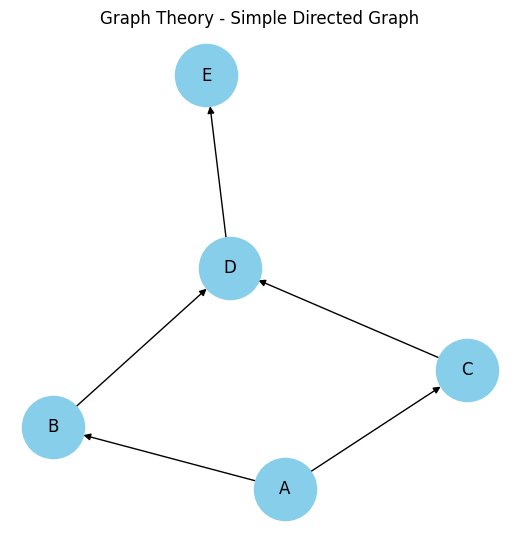import networkx as nx
import matplotlib.pyplot as plt
# Create a directed graph
G = nx.DiGraph()
# Add edges (connections)
edges = [
("A", "B"),
("A", "C"),
("B", "D"),
("C", "D"),
("D", "E")
]
G.add_edges_from(edges)
# Draw the graph
plt.figure(figsize=(5, 5))
nx.draw(
G,
with_labels=True,
node_color="skyblue",
edge_color="black",
arrows=True,
node_size=2000,
font_size=12)
plt.title("Graph Theory - Simple Directed Graph")
plt.show()Introduction
Graph theory is the study of networks of connected objects. A graph consists of nodes (vertices) and edges (connections). If edges have a direction, it’s a directed graph (digraph); otherwise, it’s undirected.
Why is Graph Theory Important?
- Navigation & Routing - Used in GPS systems, internet routing, and traffic optimization.
- Social Networks - Helps analyze connections and influence, like in Facebook or Twitter.
- Data Relationships - Useful in databases, recommendation systems (Netflix, Amazon), and web linking (Google’s PageRank).
- Biology & Chemistry - Helps model DNA structures, chemical compounds, and disease spread.
- Artificial Intelligence - Used in neural networks, decision trees, and search algorithms.
- Project Management - Critical path analysis in workflows and task dependencies.
Applications
Question 1: Shortest Path in a Road Network (Dijkstra’s Algorithm)
A logistics company called Home Logistics wants to determine the most efficient route between two cities in a given road network. The network is represented as a graph where cities are nodes and roads are edges with weights corresponding to the travel distance (in kilometers).
Given the following graph representation of a road network, write a Python program using Dijkstra’s Algorithm to find the shortest path from City A to City F.
Graph Data (as adjacency list):
roads = {
'A': {'B': 4, 'C': 2},
'B': {'A': 4, 'C': 5, 'D': 10},
'C': {'A': 2, 'B': 5, 'D': 3, 'E': 8},
'D': {'B': 10, 'C': 3, 'E': 6, 'F': 2},
'E': {'C': 8, 'D': 6, 'F': 4},
'F': {'D': 2, 'E': 4}
}Answer
# Create graph
G = nx.Graph()
edges = [
("A", "B", 4),
("A", "C", 2),
("B", "C", 5),
("B", "D", 10),
("C", "D", 3),
("C", "E", 8),
("D", "E", 6),
("D", "F", 2),
("E", "F", 4)
]
G.add_weighted_edges_from(edges)
# Compute shortest path from A to F
path = nx.shortest_path(
G,
source="A",
target="F",
weight="weight")
distance = nx.shortest_path_length(
G,
source="A",
target="F",
weight="weight")
print("Shortest Path:", path)
print("Total Distance:", distance, "km")Shortest Path: ['A', 'C', 'D', 'F']
Total Distance: 7 kmQuestion 3: Maximum Flow in a Water Distribution System (Ford-Fulkerson Algorithm)
A city’s water supply system consists of reservoirs, pipelines, and distribution points. The system is represented as a directed graph, where nodes represent junctions (reservoirs or city areas) and edges represent water pipelines with capacity limits. Given the following network, where the source is S (reservoir) and the sink is T (city distribution center), use the Ford-Fulkerson algorithm to determine the maximum amount of water that can be transported to the city.
Graph Representation (with capacities):
water_network = {
'S': {'A': 16, 'B': 13},
'A': {'B': 10, 'C': 12},
'B': {'D': 14},
'C': {'B': 9, 'T': 20},
'D': {'C': 7, 'T': 4},
'T': {}
}Write a Python program to compute the maximum flow from S to T.
Answer
# Create directed graph with capacities
G = nx.DiGraph()
edges = [
("S", "A", 16),
("S", "B", 13),
("A", "B", 10),
("A", "C", 12),
("B", "D", 14),
("C", "B", 9),
("C", "T", 20),
("D", "C", 7),
("D", "T", 4)
]
G.add_weighted_edges_from(
edges,
weight="capacity")
# Compute max flow from S to T
flow_value, flow_dict = nx.maximum_flow(G, "S", "T")
print("Maximum Flow:", flow_value, "units")Maximum Flow: 23 unitsDisclaimer: For information only. Accuracy or completeness not guaranteed. Illegal use prohibited. Not professional advice or solicitation. Read more: /terms-of-service
Reuse
Citation
@misc{kabui2025,
author = {{Kabui, Charles}},
title = {Graph {Theory}},
date = {2025-03-31},
url = {https://toknow.ai/posts/computational-techniques-in-data-science/graph-theory/index.html},
langid = {en-GB}
}
